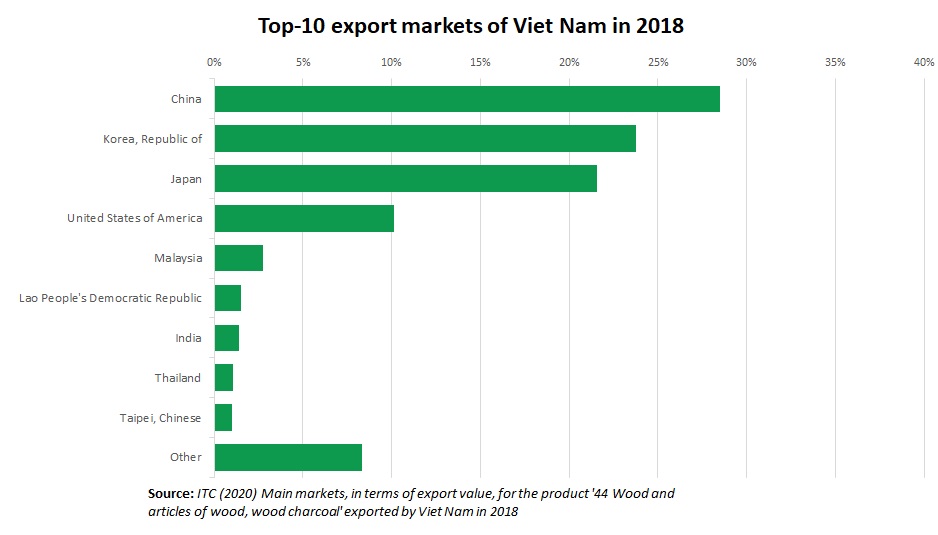Overview of timber sector of Viet Nam
Supply chain actors
Viet Nam has about 4,500 wood processing enterprises that are involved in export, of which 95% are privately owned and 5% are state owned. Of these enterprises 93% are small or very small, 5.5% are medium, and 1.5% big (Source: same as above). The relatively low-cost labour force and the favourable environment for foreign investment are the main competitive advantages of the Vietnamese industry.
Production and processing
Wood sourced from Vietnamese forests mostly originates from plantations, because of the logging and export bans that are in place. According to MARD (2019) the Vietnamese “mass” plantation forests (i.e. not including scattered trees) produced about 16 million m3 of logs in 2019, which is mainly used for processing by the domestic industry. Species most commonly used in forest plantations are Acacia (Acacia spp.) and Eucalyptus (Eucalyptus spp.) (VIFOREST, 2019).
The wood-processing industry, in 2019, in total used about 46 million m3 of timber in roundwood equivalent (RWE) volume, including about 10 million m3 for the domestic market and 36 million m3 for export markets (VIFOREST and FPA Binh Dinh, 2020).
Viet Nam, therefore, is a net importer of timber and mostly a “processing” country for the export sector. As a result, Viet Nam’s wood processing sector is highly dependent on imported materials from a large number of sources. In 2019, Vietnam imported timber and timber products for a value of about USD 2.55 billion (Vietnam Customs) from mainly China (26%), African countries (19%), the US (13%) and the EU (11%).
Viet Nam's wood processing industry is particularly known for production and export of high-end wood products, particularly furniture. Viet Nam is one of the world's largest exporting countries of timber and timber products, with exports valued at USD 10.3 billion in 2019, of which the exports of primary timber products were “only” valued at USD 3.4 billion.
Besides furniture the main export products of the Vietnamese wood product industries are wood chips and paper, with Viet Nam being one of the biggest wood chip exporting countries of the world. The main destination markets for the exports of wood chips are China (57%) and Japan (30%), totalling 12 million Bone Dry Tons (BDT) in 2019 (VIFOREST, FPA BD, HAWA, BIFA & Vietnam Customs, 2020).
Export
The main destination markets for the exports of wood products (all products, except furniture and pulp and paper products) are the USA (50%), Japan (12%) and China (12%).

Logistics infrastructure
Timber products are exported from Viet Nam in a number of ways:
- Directly by timber processors, to overseas retailers or importers.
- By processors through traders in Viet Nam with links to external markets.
- By processors to overseas companies operating in Viet Nam who then export the products (TFT, 2014).
Viet Nam has a number of ports, but the biggest ports from North to South are:
- Cai Lan in Quang Ninh Province
- Hai Phong (Hai Phong Province), Viet Nam's most important seaport in the North
- Da Nang (Da Nang City), towards the middle of Viet Nam
- Dung Quat in Quang Ngai Province
- Quy Nhon in Binh Dinh Province
- Cat Lai in Ho Chi Minh City, Viet Nam's biggest seaport
- Thi Vai-Cai Mep in Ba Ria-Vung Tau Province, and
- Can Tho (Can Tho Province).
Data table
| Production (X 1000m3) |
Imports (X 1000m3) |
Domestic consumption (X 1000m3) |
Exports (X 1000m3) |
|
|---|---|---|---|---|
| logs | 25.000 | 3.548 | 28.445 | 103 |
| Sawnwood | 6.000 | 1.838 | 7.200 | 637 |
| Veneer | 1.052 | 77 | 578 | 551 |
| Plywood | 1.050 | 493 | 509 | 1.034 |
ITTO (2019), data 2017


